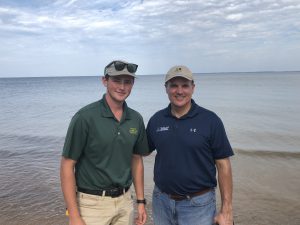Secretary’s Message: January 2019
Cheers to a Half-Century of Conservation Management and Stewardship
Happy New Year!
We welcome 2019 as a milestone in our mission as the Maryland Department of Natural Resources will celebrate its semicentennial anniversary July 1.
Under the leadership of then-Gov. Marvin Mandel, the department was formed in 1969 as a merger of five existing state agencies, the departments of Chesapeake Bay Affairs, Game and Inland Fish, Water Resources, Forest and Parks and Maryland Geological Survey. The department assumed most operations of the previously existing Board of Natural Resources, which itself was a descendent of the state Conservation Commission.
Of course, the work we do dates back farther than 1969. While laws governing fish and wildlife date back to 1654, the first formal agencies to manage natural resources began in the 19th century. The farthest back any department function dates is 1834, when the first State Geological Survey was established, the predecessor to today’s Maryland Geological Survey. Today’s Natural Resources Police trace their roots back to the Oyster Police organized in 1868, the longest continuing service by any of our units.
Maryland first employed fish commissioners in 1870 and state game wardens began service in 1896. The Board of Forestry, created in 1906, is predecessor to both the Maryland Forest Service and Maryland Park Service.
We honor this history as we look to the future. In this past half-century, our agency has been a part of many great success stories…in wildlife conservation, land preservation, bay restoration and ever-growing opportunities to connect Marylanders with the natural world.
Through effective management practices, we have seen a return and growth of many species in Maryland. We have grown our park system to include more than 75 state parks, and our department now protects and provides access to more than a half-million acres of public lands and thousands of miles of trails on land and water.
We’ve made tremendous progress toward restoring the Chesapeake Bay with an improved outlook for underwater grasses and the overall quality of the estuary that is essential to state’s culture, economy and environment. We’ve restored thousands of acres of wetlands and planted stream buffers to protect our waterways.
Much has been gained and sustained, but many challenges remain. Our department is now at the forefront of Maryland’s efforts on climate change, specifically adaptation and resiliency, helping our communities understand and prepare for challenges, including flooding, rising seas and land subsidence. And we must continue to be vigilant to maintain the work and sacrifice many Marylanders have made to manage our wildlife and restore our bays.
Today, more than 1,300 employees along with countless volunteers are meeting these challenges head on, working to enhance, preserve, protect and restore Maryland’s natural resources. We continue working to educate and engage our students and young adults to develop the next generation of stewards, who lead us into the future.
We’re proud of the work we do, but as always I must thank you, the outdoor activists, advocates and enthusiasts of Maryland, who continue to be our most important partner and ally in our mission and vision.
Sir Isaac Newton once wrote, “If I have seen further, it is by standing on (the) shoulders of giants.”
With eyes on both past and future, and with your continued help and support, we look forward to the next 50 years and beyond.


 1-888-373-7888
1-888-373-7888 233733
233733